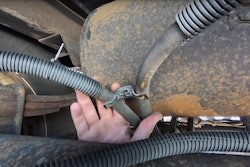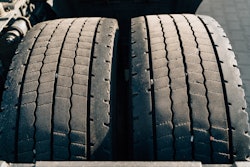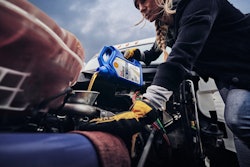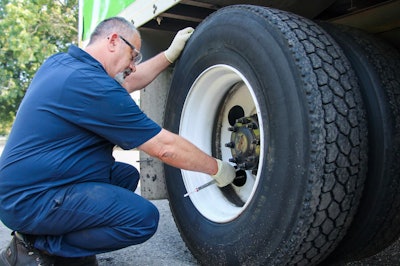
While there are several important steps to take to prepare a truck for winter, the latest addition to that critical to-do list is arguably one of the most important: Advanced Driver Assistance System (ADAS) maintenance.
The list of ADAS features on newer Class 8 trucks is long and growing with automatic braking, lane departure alerts and automatic cruise control topping the list of favorites.
However, if ADAS components are not properly maintained during freezing, snow-filled winters, that can mean losing that all-important edge on safety.
“Advance Driver Safety Systems rely on cameras and radars to identify road markings, signs, surrounding vehicles, pedestrians and other threats,” said Joe Puff, vice president of truck technology and maintenance at NationaLease.
“These safety components require clean, unobstructed, and precise mounting to operate effectively,” Puff continued. “In the winter, these components can get packed with dirt, snow, and ice making the system less effective or causing it not to work at all. Drivers should regularly inspect the cameras and radars to ensure they are unobstructed and clean.”
[Related: Filters forgotten during extended service intervals]
Chuck Brodie, field service team leader for commercial vehicle solutions at ZF Group said it’s important to educate drivers on what can happen if they don’t keep ADAS components free of snow and ice.
“If this happens the driver will get a warning on the dash letting them know the system is temporarily not available,” Brodie said. “It is acceptable to continue driving when this occurs, but drivers should clear the blockage and in some cases may need to cycle the ignition off for a few minutes once they are out of the weather that caused the blockage.”
Keep brakes and air system in top shape
Automated braking may not do anyone much good if braking components aren’t prepped for winter. First up is the air system.“Moisture in the air system is detrimental and reduces the ability of the vehicle to stop adequately,” said Matt Copot, vice president of maintenance at Transervice. “Inspect the air dryer, drain the vehicle’s air tanks daily, and check the dryer filter. If the dryer has a heater, make sure it works.”
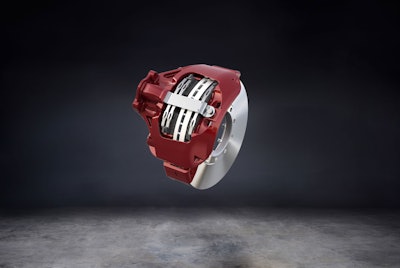 "Another side effect we have seen with salt road de-icers is increased occurrence of sticking brakes," said Joe Kay, Meritor's director of engineering. "This is a problem operators experience typically when a truck or trailer has the corrosive slurry on the brake surfaces. When the operator sets the parking brake, the vehicle may sit for several days. The corrosive environment, along with the parking brake set, will form an adhesion on the pad to rotor or drum because of the gray iron corroding."Meritor EX+ LS Air Disc Brake
"Another side effect we have seen with salt road de-icers is increased occurrence of sticking brakes," said Joe Kay, Meritor's director of engineering. "This is a problem operators experience typically when a truck or trailer has the corrosive slurry on the brake surfaces. When the operator sets the parking brake, the vehicle may sit for several days. The corrosive environment, along with the parking brake set, will form an adhesion on the pad to rotor or drum because of the gray iron corroding."Meritor EX+ LS Air Disc Brake
Drew Kortyna, vice president of commercial operations with Cox Automotive Mobility Fleet Services, said draining moisture out of the air system daily can help prevent airline freezing.
"Too much moisture collecting in the air tanks during the winter months can ultimately lead to emergency breakdowns," Kortyna said.
Using alcohol to address moisture in the air system is not advisable.
“Some fleets pour alcohol in the trailer air lines to prevent freezing or melt ice in the systems. We advise against doing that as the alcohol could affect the seals in the valves,” Brodie said. “Alcohol evaporators are a more acceptable alternative. It is much better to maintain your air system so that water does not get into it in the first place.”
Preventing water from entering the air system is a good year-round practice and especially important during winter.
“It is good practice to store trailers and air lines in a manner that prevents water and debris from getting directly into the glad hands,” Brodie said. “Much like the dryer maintenance, this is relevant year-round but more significant in the months when the water that gets in the lines could freeze and prevent you from releasing the trailer brakes.”
Other brake issues can crop up from easily overlooked sources like road de-icers, which use salt to melt ice. Meritor’s Director of Engineering Joe Kay pointed out that in addition to accelerating corrosion and breaking down grease and lubricants, which can lead to seal damage, this salty road slurry can also create serious brake issues.
“Another side effect we have seen with salt road de-icers is increased occurrence of sticking brakes,” Kay said. “This is a problem operators experience typically when a truck or trailer has the corrosive slurry on the brake surfaces. When the operator sets the parking brake, the vehicle may sit for several days. The corrosive environment, along with the parking brake set, will form an adhesion on the pad to the rotor or drum because of the gray iron corroding.”
Kay said it’s best to use shields when possible to protect brakes from corrosive slurry. Drivers should also be trained, he said, to warm the brakes before parking. Dragging the brakes slightly in the parking lot will warm the drum and hopefully evaporate any moisture, which will help to reduce the corrosive effects, he said.
Sand that’s applied to icy roads to improve traction can lead to braking problems, too.
“The negative effect on foundation brakes is the abrasiveness of the sand when it gets between the friction material and the rotor or drum,” Kay said. “This, too, can accelerate wear. Some fleets have found dust shields help in these extreme conditions.”
Coolant and other fluids
Though it’s often a bigger focus during the hotter summer months, a truck’s cooling system should also undergo a thorough check for winter.“Coolant systems require routine maintenance, and winter prep is critical for an effective season of driving,” Puff said. “Coolant systems should be pressure tested for leaks, freeze protection level, and don’t forget to add the same coolant type to the system. There are many coolant types with varying technology, and adding the wrong coolant could deplete the inhibitors, causing many very expensive repairs down the road.”
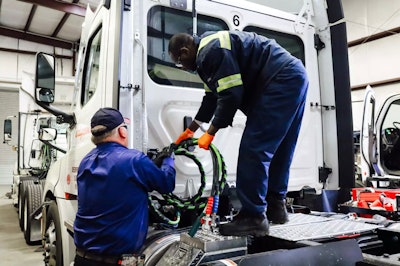 Store glad hands to keep moisture at bay.Transervice
Store glad hands to keep moisture at bay.Transervice
Wherever coolant flows, check those areas to ensure proper function.
“Check hoses, clamps, water pump and the radiator for leaks, cracks, dry rot, and ensure that the coolant freeze point is to your specifications,” Copot said.
Kortyna said, "If the freeze point is not at least -30 °F, concentrated antifreeze should be added to lower the freeze point."
Coolant isn’t the only fluid under the hood that could warrant a change as fall temperatures begin to slide.
“Consider changing windshield washer fluid, which is typically good to about 20 degrees Fahrenheit, to a fluid that is more of a de-icer that will work to -20 degrees Fahrenheit,” said Mark Finger, Transervice’s vice president of operations.
“Don’t waste time waiting for your windshield to defrost,” added Jon Salter, director of shop operations for Pilot Flying J Truck Care. “By adding anti-frost and anti-fog treatments, you can hit the road and be on your way.”
Copot advised checking wiper blades, the washer fluid reservoir and the washer pump to ensure they work properly. "Make sure there is a proper spray pattern from the washer nozzles on the windshield,” he said.
Gino Fontana, chief operating officer and executive vice president at Transervice, suggested adding a windshield washer fluid heater or heated wiper blades to trucks that operate in extremely cold temperatures.
Battery and other electrical tips
Batteries do not perform as well in colder temperatures, which makes checking them all the more important prior to turning trucks loose in freezing temperatures where battery breakdowns can incur costly roadside service. Cold engines require much more battery power to start, and heat is damaging to a battery. The damage done to a truck’s battery during the summer months may not reveal itself until the onset of cold weather.
“Service and test batteries individually by performing a load test on each of them,” Copot said. “In addition, check the battery age as older batteries can have reduced output during extreme low temperatures.”
Homer Hogg, vice president of truck services for TravelCenters of America, said winter can be more taxing overall on the electrical system.
“Winter also means driving during extended periods of darkness, which can cause stress to your alternator,” Hogg said. “Test your alternator’s ability to produce voltage and amperage now to help avoid some serious downtime this winter.”
Puff said a simple smart battery tester or carbon pile load tester can tell a lot about a battery’s health, adding that a discharged battery can freeze at around 30 degrees Fahrenheit while a fully charged one will begin to freeze only at lower temperatures.
Fontana suggested checking all exposed wiring for cuts and nicks, as corrosive road de-icing chemicals will use those openings as entry points into the electrical system.
“Make sure wiring connections are tight and clean, and then coat them with dielectric grease or spray to prevent corrosion from developing on wiring,” Fontana said.
Don’t forget belts
Belts often are forgotten, but Hogg said they deserve special attention ahead of winter. When the temperature drops, belts can snap if they’re in poor condition.“It is very difficult, if not impossible, to visually detect a bad belt,” he said. “Modern belts are made of ethylene propylene diene monomer (EPDM), which will not show visible signs of wear. A gauge must be used to detect the wear condition of the belt.”
Hogg recommended checking the entire belt drive system, including tensioners and pullers. The rule of thumb is to replace the tensioner during every other belt replacement.
“Lastly, don’t forget to check belt alignment,” he said. “The chirping sound that we often hear in the belt drive system is typically caused by a belt that is not aligned properly.”
Fuel system and other tips
Copot suggested following these other steps to help ensure better truck performance during winter:Fuel System
· Check your fuel filters and water separator as you do not want moisture in your fuel. Moisture in the fuel will cause fuel restrictions or contamination.
· Check your fuel tanks for any water and drain accordingly.
HVAC System
· Check your heater and defroster. Make sure everything functions including direction of air flow and the blower strength so you can have effective defrosting.
Tires
· Check your tires and tire chains where applicable. Make sure your tires are within tire program pull points and properly inflated as cold temperatures will lower the pressures, and snow will reduce traction.
Kortyna said tire maintenance is often overlooked during the winter even though tire pressure should be checked more frequently during the colder months than any other time of year.
"In general, tires can lose or gain 1-2 PSI for every 10-degree temperature change so the drastic winter weather can really put them at risk," Kortyna said. "Tires should be checked daily to ensure they can properly provide traction on icy and wet roads. Checking the tire pressure becomes a matter of not only efficiency, but also safety."

